Assessing Agri-Food Digitalization: Insights from Bibliometric and Survey Analysis in Andalusia
Abstract
1. Introduction
2. Materials and Methods
2.1. Bibliometric Analysis
2.1.1. Search Strategy
2.1.2. Data Collection
2.1.3. Data Analysis and Visualization
2.2. Stakeholder Survey
2.2.1. Study Design
2.2.2. Sampling Strategy
2.2.3. Data Analysis
3. Results and Discussion
3.1. Global Research Trends in Agri-Food Digitalization
3.2. Digital Adoption: Stakeholder Insights from Andalusia
3.2.1. Survey Findings
3.2.2. A Comparison with National and Global Contexts
3.3. Bridging Research and Practice: Challenges and Opportunities
3.3.1. Alignments and Divergences: Research vs. Stakeholder Priorities
3.3.2. Actionable Strategies for Enhancing Digital Adoption
- Tailored Financial Support: Our analysis shows that high initial costs are a significant barrier, especially for the small and medium-sized farms that predominate in Andalusia. This is why we recommend designing targeted and differentiated instruments such as tax deductions for digital investments (software, sensors, and machinery), direct grants, or low-interest loans for agricultural SMEs. Support for maintenance and technological upgrades is equally important to ensure the viability of investments and avoid premature obsolescence.
- Digital Literacy and Ongoing Training Programs: As shown in our study sample, the digital skills gap remains a major barrier to technology adoption, even among young and well-educated individuals. Policies should establish free and accessible training plans in collaboration with agricultural research centers, cooperatives, and professional organizations. These programs should cover not only the basic digital concepts addressed in Clusters 1 and 3 of the analysis, but also advanced tools such as crop management platforms and AI for agronomic decision-making, included in Clusters 4 and 5. Training should be practical, accessible in rural areas, and tailored to different socio-professional profiles.
- The Integration of Digitalization into Sectoral Policies: Digital transformation needs to be integrated into major agricultural policies, such as the Common Agricultural Policy (CAP). This could involve aligning digitalization goals with existing tools, for example, funding digital solutions through eco-schemes, explicitly supporting technological upgrades in investment aid, or linking priority access to new technologies with efforts to encourage generational renewal and a greater inclusion of women in the sector. In this context, the digital farm record, which will soon be introduced in Spain, offers a promising starting point for developing practical use cases and creating value among willing stakeholders.
- Innovation Hubs and Networks: Initiatives such as the “Andalucía Agrotech DIH” hub [98] and its involvement in the HIBA (Hub Iberia Agrotech) [26] project have built networks connecting SMEs, startups, universities, and public administrations. These hubs offer advisory services, training, and promote co-creation through technology challenges like “Plataforma Iberia Conecta”.
- Sector-Specific Living Labs: Experiences such as the European ZeroW project (focused on reducing food waste in the fruit and vegetable sector) [99] or the territorial lab in Los Pedroches as part of the I-CISK project (digital water management in livestock farming) [100] illustrate the potential of participatory approaches. In these initiatives, cooperatives, research centers, and producers work together to develop technologies tailored to local conditions.
- Demonstration Pilot Projects: Initiatives such as Inverconec (integration of technologies in greenhouses in Almería) [101] and FerTICycle (application of IoT to manure management) [102] demonstrate how digitalization is being put into practice in real production contexts, generating both tangible benefits and greater trust among stakeholders.
- Catalytic Role of Cooperatives: The strategic capacity of cooperatives to drive innovation from the ground up is particularly crucial in Andalusia, given their central role and the modernization challenges previously identified [31]. They act as key players in the regional ecosystem, especially with more mature technologies like those included in Cluster 1 or in parts of Cluster 3. Examples such as COVAP’s investment in the RUMI system (livestock monitoring) [103], the RAVSA3 platform (the digital valorization of by-products) [104], and programs led by Cooperativas Agro-alimentarias de Andalucía (“Organización 5.0”, digital mentoring) [105] highlight the importance of continuing these initiatives, as they have proven effective in advancing digitalization.
- Leverage Areas of Strong Alignment: There is a strong alignment between global research and the priorities of Andalusian stakeholders regarding technologies related to Cluster 1 and part of Cluster 3. These focus on optimizing the management of key resources, such as soil management, irrigation and fertilizer control, and crop monitoring using sensors and remote sensing tools. Future actions should capitalize on this convergence by promoting adoption, while ensuring that it is done in a way that minimizes additional workload for farmers. The key lies in the seamless integration of these tools into intuitive Farm Management Software (FMS) that is centered on real-world operations. Value is maximized when the FMS is designed so that farmers mainly need to record the data they already generate in their daily routines (e.g., planting dates, treatments applied, work logs). The platform would then automatically incorporate and process information from sensors and other connected devices, presenting unified analyses and recommendations without requiring a constant, specific data entry for each new technology. Recent advances, such as the integration of LLMs into FMS platforms, can further streamline this process by enabling more natural, context-aware interactions and automating routine decision support tasks. Building on this familiarity, along with the perceived value of these technologies, can provide a strong entry point for more complex, progressive digitalization processes.
- Simplifying the Complex: In contrast to the previous point, our analysis reveals a clear divergence regarding the advanced technologies included in Clusters 4 and 5, such as AI, big data, and predictive analytics. Overcoming this barrier requires a conscious effort to simplify and adopt user-centered design. This includes integrating these technologies into intuitive interfaces (such as visual dashboards or voice commands), developing plug-and-play systems to enable easy interaction, promoting functional modularity (starting simple and scaling up later), ensuring models are tailored to local contexts (by validating with local data to build trust and relevance), and providing ongoing, targeted technical support and training for these tools. A promising strategy in this direction is to integrate predictive models (phenological models, yield predictions, disease identification, etc.) directly into existing FMS. The key is not just to display results, but to design a dynamic interaction: allowing users, for example, to easily input corrections or feedback if they notice a deviation in a model prediction. This user input could trigger an automatic adjustment of the model’s parameters, providing recalibrated predictions instantly. Such an approach would transform the model from an opaque ‘black box’ into a transparent, collaborative tool, where users actively participate in its calibration and continuous improvement, boosting trust, acceptance, and accuracy for their specific context.
- Linking Environmental Sustainability and Economic Profitability: A divergence was also identified in the environmental focus and the technologies covering the Cluster 2. Digital tools with an environmental focus (such as input optimization or water/carbon footprint tracking) should be framed and promoted by highlighting their direct or indirect economic benefits. It is essential to support studies and use cases that rigorously quantify the economic return of these technology-enabled sustainable practices, directly addressing the main concern of producers.
- Developing Market Transparency Tools and Promoting Data Sharing: In response to the clear demand from stakeholders for a greater market transparency (prices, volumes, and real-time trends), the strategy should focus on creating collaborative tools based on incentivized data sharing. The proposed model is one in which actors, such as producers and cooperatives, contribute certain data of their own (e.g., harvest forecasts and volumes sold) in order to access high-value, real-time aggregated information (such as average market prices or total volumes by region). This “give to get” approach directly addresses the barrier of lacking a perceived direct benefit, as identified in our analysis. Promoting the creation of this collective database, ideally through public-private collaboration projects, would not only provide an immediate market intelligence but also lay the groundwork for more advanced use cases, such as price prediction models or sector-wide production estimates. In addition, an even greater value could be realized if interoperable systems are built, allowing this collective intelligence to be visualized and integrated directly into each participant’s individual management systems (ERPs and business platforms).
- It is essential to promote the use of open standards and shared data formats. Public administrations can help catalyze this by establishing regulations that encourage public APIs and compatible data exchange schemes, enabling different systems to work together [92].
- Interoperability should be addressed from the design phase, ensuring systems are modular, adaptable, and compatible with existing infrastructure. This requires close collaboration between developers and users, as well as possible compatibility certifications. This need is especially critical in Andalusia, given the diversity of technological solutions currently in use.
- Interoperability is also key to advancing the agri-food data economy, making it possible to build ecosystems where data can be reused securely and transparently, while respecting data sovereignty, privacy, and trust. Naturally, this requires the development of clear governance frameworks for ownership, privacy, and security [73,74].
3.4. Limitations and Future Research
4. Conclusions
Supplementary Materials
Author Contributions
Funding
Institutional Review Board Statement
Informed Consent Statement
Data Availability Statement
Acknowledgments
Conflicts of Interest
References
- Shamshiri, R.R.; Sturm, B.; Weltzien, C.; Fulton, J.; Khosla, R.; Schirrmann, M.; Raut, S.; Basavegowda, D.H.; Yamin, M.; Hameed, I.A. Digitalization of Agriculture for Sustainable Crop Production: A Use-Case Review. Front. Environ. Sci. 2024, 12, 1375193. [Google Scholar] [CrossRef]
- Gyamfi, E.K.; ElSayed, Z.; Kropczynski, J.; Yakubu, M.A.; Elsayed, N. Agricultural 4.0 Leveraging on Technological Solutions: Study for Smart Farming Sector 2024. In Proceedings of the 2024 IEEE 3rd International Conference on Computing and Machine Intelligence (ICMI), Mt Pleasant, MI, USA, 13–14 April 2024. [Google Scholar]
- Da Silveira, F.; Lermen, F.H.; Amaral, F.G. An Overview of Agriculture 4.0 Development: Systematic Review of Descriptions, Technologies, Barriers, Advantages, and Disadvantages. Comput. Electron. Agric. 2021, 189, 106405. [Google Scholar] [CrossRef]
- Klerkx, L.; Jakku, E.; Labarthe, P. A Review of Social Science on Digital Agriculture, Smart Farming and Agriculture 4.0: New Contributions and a Future Research Agenda. NJAS Wagening. J. Life Sci. 2019, 90–91, 1–16. [Google Scholar] [CrossRef]
- Abu, N.S.; Bukhari, W.M.; Ong, C.H.; Kassim, A.M.; Izzuddin, T.A.; Sukhaimie, M.N.; Norasikin, M.A.; Rasid, A.F.A. Internet of Things Applications in Precision Agriculture: A Review. J. Robot. Control JRC 2022, 3, 338–347. [Google Scholar] [CrossRef]
- Wolfert, S.; Ge, L.; Verdouw, C.; Bogaardt, M.-J. Big Data in Smart Farming—A Review. Agric. Syst. 2017, 153, 69–80. [Google Scholar] [CrossRef]
- Sugandh, U.; Nigam, S.; Misra, S.; Khari, M. A Bibliometric Analysis of the Evolution of State-of-the-Art Blockchain Technology (BCT) in the Agrifood Sector from 2014 to 2022. Sensors 2023, 23, 6278. [Google Scholar] [CrossRef]
- Zhang, Y. A Path to Sustainable Development of AGRI-INDUSTRIES: Analysis of Agriculture 5.0 versus Industry 5.0 Using Stakeholder Theory with Moderation of Environmental Policy. Sustain. Dev. 2024, 32, 4829–4843. [Google Scholar] [CrossRef]
- Bergier, I.; Barbedo, J.G.A.; Bolfe, É.L.; Romani, L.A.S.; Inamasu, R.Y.; Massruhá, S.M.F.S. Framing Concepts of Agriculture 5.0 via Bipartite Analysis. Sustainability 2024, 16, 10851. [Google Scholar] [CrossRef]
- Raji, I.; Njoku, T.K. Data-Driven Decision Making in Agriculture: Enhancing Productivity and Sustainability through Predictive Analytics. Int. J. Res. Publ. Rev. 2024, 5, 2708–2719. [Google Scholar] [CrossRef]
- Bertoglio, R.; Corbo, C.; Renga, F.M.; Matteucci, M. The Digital Agricultural Revolution: A Bibliometric Analysis Literature Review. IEEE Access 2021, 9, 134762–134782. [Google Scholar] [CrossRef]
- Mühl, D.D.; De Oliveira, L. A Bibliometric and Thematic Approach to Agriculture 4.0. Heliyon 2022, 8, e09369. [Google Scholar] [CrossRef] [PubMed]
- Dibbern, T.; Romani, L.A.S.; Massruhá, S.M.F.S. Main Drivers and Barriers to the Adoption of Digital Agriculture Technologies. Smart Agric. Technol. 2024, 8, 100459. [Google Scholar] [CrossRef]
- Paudel, B.; Riaz, S.; Teng, S.W.; Kolluri, R.R.; Sandhu, H. The Digital Future of Farming: A Bibliometric Analysis of Big Data in Smart Farming Research. Clean. Circ. Bioecon 2025, 10, 100132. [Google Scholar] [CrossRef]
- Da Silveira, F.; Da Silva, S.L.C.; Machado, F.M.; Barbedo, J.G.A.; Amaral, F.G. Farmers’ Perception of the Barriers That Hinder the Implementation of Agriculture 4.0. Agric. Syst. 2023, 208, 103656. [Google Scholar] [CrossRef]
- Makinde, A.; Islam, M.M.; Wood, K.M.; Conlin, E.; Williams, M.; Scott, S.D. Investigating Perceptions, Adoption, and Use of Digital Technologies in the Canadian Beef Industry. Comput. Electron. Agric. 2022, 198, 107095. [Google Scholar] [CrossRef]
- Smidt, H.J.; Jokonya, O. Factors Affecting Digital Technology Adoption by Small-Scale Farmers in Agriculture Value Chains (AVCs) in South Africa. Inf. Technol. Dev. 2022, 28, 558–584. [Google Scholar] [CrossRef]
- Ezeaku, C.; Ani, A.O.; Adama, J.; Job, V.; Sule, S.; Onwualu, A.; Nwankwojike, B.; Otoijamun, I.; Ogbobe, P. Willingness to Adopt Precision Agriculture: An Analysis of Gombe and Bauchi States of Nigeria. Niger. J. Technol. 2024, 43, 198–206. [Google Scholar] [CrossRef]
- Gabriel, A.; Gandorfer, M. Adoption of Digital Technologies in Agriculture—An Inventory in a European Small-Scale Farming Region. Precis. Agric. 2023, 24, 68–91. [Google Scholar] [CrossRef]
- Jerhamre, E.; Carlberg, C.J.C.; Van Zoest, V. Exploring the Susceptibility of Smart Farming: Identified Opportunities and Challenges. Smart Agric. Technol. 2022, 2, 100026. [Google Scholar] [CrossRef]
- Suresh, K.; Narmilan, A.; Ahmadh, R.K.; Kariapper, R.; Nawaz, S.S.; Suresh, J. Farmers’ Perception on Precision Farming Technologies: A Novel Approach. INDIAN J. Agric. Econ. 2022, 77, 264–276. [Google Scholar] [CrossRef]
- Yeo, M.L.; Keske, C.M. From Profitability to Trust: Factors Shaping Digital Agriculture Adoption. Front. Sustain. Food Syst. 2024, 8, 1456991. [Google Scholar] [CrossRef]
- Maudos, J.; Salamanca, J. Observatorio Sobre El Sector Agroalimentario Español En El Contexto Europeo: Informe 2023; Cajamar Caja Rural: Almería, Spain, 2024. [Google Scholar]
- López del Paso, R.; Becerra Benítez, F. El Sector Agrario y La Industria Alimentaria En España. Principales Rasgos y Análisis Regional En 2023; Analistas Económicos de Andalucía: Málaga, Spain, 2024. [Google Scholar]
- De RIS3Andalucia a S4Andalucia. Available online: https://ris3.s4andalucia.es/de-ris3-a-s4/ (accessed on 18 November 2024).
- HUB Iberia Agrotech. Available online: https://hubiberiaagrotech.eu/ (accessed on 18 November 2024).
- MAPA. Estrategia de Digitalización Del Sector Agroalimentario y Forestal y Del Medio Rural. Available online: https://www.mapa.gob.es/es/ministerio/planes-estrategias/estrategia-digitalizacion-sector-agroalimentario/ (accessed on 18 November 2024).
- European Commission. Horizon 2020. Available online: https://research-and-innovation.ec.europa.eu/funding/funding-opportunities/funding-programmes-and-open-calls/horizon-2020_en (accessed on 20 November 2024).
- TEF Agrifood. Available online: https://www.agrifoodtef.eu/ (accessed on 20 November 2024).
- Sadjadi, E.N.; Fernández, R. Challenges and Opportunities of Agriculture Digitalization in Spain. Agronomy 2023, 13, 259. [Google Scholar] [CrossRef]
- Santos, F.J.; Guzmán, C.; Ahumada, P. Assessing the Digital Transformation in Agri-Food Cooperatives and Its Determinants. J. Rural. Stud. 2024, 105, 103168. [Google Scholar] [CrossRef]
- Parra-López, C.; Reina-Usuga, L.; Garcia-Garcia, G.; Carmona-Torres, C. Promoting Digital Traceability in Agriculture: A Predictive Approach to Adoption and Policy Design in the Olive Sector. Technol. Forecast. Soc. Change 2025, 215, 124077. [Google Scholar] [CrossRef]
- Latino, M.E.; Menegoli, M.; Corallo, A. Agriculture Digitalization: A Global Examination Based on Bibliometric Analysis. IEEE Trans. Eng. Manag. 2022, 71, 1330–1345. [Google Scholar] [CrossRef]
- Xu, J.; Li, Y.; Zhang, M.; Zhang, S. Sustainable Agriculture in the Digital Era: Past, Present, and Future Trends by Bibliometric Analysis. Heliyon 2024, 10, e34612. [Google Scholar] [CrossRef]
- Grosseck, G.; Țîru, L.G.; Bran, R.A. Education for Sustainable Development: Evolution and Perspectives: A Bibliometric Review of Research, 1992–2018. Sustainability 2019, 11, 6136. [Google Scholar] [CrossRef]
- Iaksch, J.; Fernandes, E.; Borsato, M. Digitalization and Big Data in Smart Farming—Bibliometric and Systemic Analysis. In Advances in Transdisciplinary Engineering; Pokojski, J., Gil, M., Newnes, L., Stjepandić, J., Wognum, N., Eds.; IOS Press: Amsterdam, The Netherlands, 2020; ISBN 978-1-64368-110-8. [Google Scholar]
- Kamran, M.; Khan, H.U.; Nisar, W.; Farooq, M.; Rehman, S.-U. Blockchain and Internet of Things: A Bibliometric Study. Comput. Electr. Eng. 2020, 81, 106525. [Google Scholar] [CrossRef]
- Coulibaly, S.; Kamsu-Foguem, B.; Kamissoko, D.; Traore, D. Deep Learning for Precision Agriculture: A Bibliometric Analysis. Intell. Syst. Appl. 2022, 16, 200102. [Google Scholar] [CrossRef]
- Fauzi, M.A. A Bibliometric Review on Knowledge Management in Tourism and Hospitality: Past, Present and Future Trends. Int. J. Contemp. Hosp. Manag. 2023, 35, 2178–2201. [Google Scholar] [CrossRef]
- Swetha Menon, N.P.; Kamaraj, M.; Anish Sharmila, M.; Govarthanan, M. Recent Progress in Polysaccharide and Polypeptide Based Modern Moisture-Retentive Wound Dressings. Int. J. Biol. Macromol. 2024, 256, 128499. [Google Scholar] [CrossRef]
- Agnusdei, G.P.; Coluccia, B. Sustainable Agrifood Supply Chains: Bibliometric, Network and Content Analyses. Sci. Total Environ. 2022, 824, 153704. [Google Scholar] [CrossRef] [PubMed]
- Öztürk, O.; Kocaman, R.; Kanbach, D.K. How to Design Bibliometric Research: An Overview and a Framework Proposal. Rev. Manag. Sci. 2024, 18, 3333–3361. [Google Scholar] [CrossRef]
- De Oliveira, F.M.; Ferraz, G.A.E.S.; André, A.L.G.; Santana, L.S.; Norton, T.; Ferraz, P.F.P. Digital and Precision Technologies in Dairy Cattle Farming: A Bibliometric Analysis. Animals 2024, 14, 1832. [Google Scholar] [CrossRef] [PubMed]
- Niknejad, N.; Ismail, W.; Bahari, M.; Hendradi, R.; Salleh, A.Z. Mapping the Research Trends on Blockchain Technology in Food and Agriculture Industry: A Bibliometric Analysis. Environ. Technol. Innov. 2021, 21, 101272. [Google Scholar] [CrossRef]
- Slimani, H.; El Mhamdi, J.; Jilbab, A. Assessing the Advancement of Artificial Intelligence and Drones’ Integration in Agriculture through a Bibliometric Study. Int. J. Electr. Comput. Eng. 2024, 14, 878. [Google Scholar] [CrossRef]
- Culot, G.; Nassimbeni, G.; Orzes, G.; Sartor, M. Behind the Definition of Industry 4.0: Analysis and Open Questions. Int. J. Prod. Econ. 2020, 226, 107617. [Google Scholar] [CrossRef]
- Fahimnia, B.; Tang, C.S.; Davarzani, H.; Sarkis, J. Quantitative Models for Managing Supply Chain Risks: A Review. Eur. J. Oper. Res. 2015, 247, 1–15. [Google Scholar] [CrossRef]
- Assis, T.I.; Gonçalves, R.F. Valorization of Food Waste by Anaerobic Digestion: A Bibliometric and Systematic Review Focusing on Optimization. J. Environ. Manag. 2022, 320, 115763. [Google Scholar] [CrossRef]
- Aria, M.; Cuccurullo, C. Bibliometrix: An R-Tool for Comprehensive Science Mapping Analysis. J. Informetr. 2017, 11, 959–975. [Google Scholar] [CrossRef]
- Van Eck, N.J.; Waltman, L. Visualizing Bibliometric Networks. In Measuring Scholarly Impact; Ding, Y., Rousseau, R., Wolfram, D., Eds.; Springer International Publishing: Cham, Switzerland, 2014; pp. 285–320. ISBN 978-3-319-10376-1. [Google Scholar]
- Python Software Foundation. Available online: https://www.python.org/ (accessed on 25 January 2025).
- Bolfe, É.L.; Jorge, L.A.D.C.; Sanches, I.D.; Luchiari Júnior, A.; Da Costa, C.C.; Victoria, D.D.C.; Inamasu, R.Y.; Grego, C.R.; Ferreira, V.R.; Ramirez, A.R. Precision and Digital Agriculture: Adoption of Technologies and Perception of Brazilian Farmers. Agriculture 2020, 10, 653. [Google Scholar] [CrossRef]
- Giua, C.; Materia, V.C.; Camanzi, L. Smart Farming Technologies Adoption: Which Factors Play a Role in the Digital Transition? Technol. Soc. 2022, 68, 101869. [Google Scholar] [CrossRef]
- Schulze Schwering, D.; Bergmann, L.; Isabel Sonntag, W. How to Encourage Farmers to Digitize? A Study on User Typologies and Motivations of Farm Management Information Systems. Comput. Electron. Agric. 2022, 199, 107133. [Google Scholar] [CrossRef]
- Etikan, I. Comparison of Convenience Sampling and Purposive Sampling. Am. J. Theor. Appl. Stat. 2016, 5, 1. [Google Scholar] [CrossRef]
- Guest, G.; Namey, E.; Chen, M. A Simple Method to Assess and Report Thematic Saturation in Qualitative Research. PLoS ONE 2020, 15, e0232076. [Google Scholar] [CrossRef]
- Soon-Sinclair, J.M.; Ha, T.M.; Vanany, I.; Limon, M.R.; Sirichokchatchawan, W.; Abdul Wahab, I.R.; Hamdan, R.H.; Jamaludin, M.H. Consumers’ Perceptions of Food Fraud in Selected Southeast Asian Countries: A Cross Sectional Study. Food Secur. 2024, 16, 65–77. [Google Scholar] [CrossRef]
- Damanik, M.; Khaliqi, M.; Nurlia, A.; Rambe, K.R.; Malau, L.R.E.; Novanda, R.R.; Ulya, N.A. Drivers of Food Waste Reduction Intention Among Indonesian Young Generation. J. Popul. Soc. Stud. 2024, 33, 1–25. [Google Scholar] [CrossRef]
- Brown, H.C.P. Young Farmers’ Willingness to Protect Species at Risk in Prince Edward Island. Biodivers. Conserv. 2023, 32, 2693–2708. [Google Scholar] [CrossRef]
- Baliyan, A.; Kaswan, K.S.; Dhatterwal, J.S. An Empirical Analysis of Python Programming for Advance Computing. In Proceedings of the 2022 2nd International Conference on Advance Computing and Innovative Technologies in Engineering (ICACITE), Greater Noida, India, 28 April 2022; IEEE: New York, NY, USA, 2022; pp. 1482–1486. [Google Scholar]
- Danya, U.; Kamaraj, M.; Suresh Babu, P.; Aravind, J. Bibliometric Analysis and Review of Food Waste Management via Sustainable Approaches. Glob. J. Environ. Sci. Manag. 2024, 10, 2127–2144. [Google Scholar] [CrossRef]
- Landgrebe, D.A.; Phillips, T.L. A Multichannel Image Data Handling System for Agricultural Remote Sensing. In Proceedings of the Computerized Imaging Techniques, Washington, DC, USA, 1 July 1967; pp. 136–145. [Google Scholar]
- Justice, C.O.; Townshend, J.R.G.; Holben, B.N.; Tucker, C.J. Analysis of the Phenology of Global Vegetation Using Meteorological Satellite Data. Int. J. Remote Sens. 1985, 6, 1271–1318. [Google Scholar] [CrossRef]
- Moran, M.S.; Inoue, Y.; Barnes, E.M. Opportunities and Limitations for Image-Based Remote Sensing in Precision Crop Management. Remote Sens. Environ. 1997, 61, 319–346. [Google Scholar] [CrossRef]
- Kamilaris, A.; Prenafeta-Boldú, F.X. Deep Learning in Agriculture: A Survey. Comput. Electron. Agric. 2018, 147, 70–90. [Google Scholar] [CrossRef]
- Liakos, K.; Busato, P.; Moshou, D.; Pearson, S.; Bochtis, D. Machine Learning in Agriculture: A Review. Sensors 2018, 18, 2674. [Google Scholar] [CrossRef] [PubMed]
- McFadden, J.; Njuki, E.; Griffin, T. Precision Agriculture in the Digital Era: Recent Adoption on U.S. Farms; U.S. Department of Agriculture, Economic Research Service: Washington, DC, USA, 2023.
- Hassoun, A.; Marvin, H.J.P.; Bouzembrak, Y.; Barba, F.J.; Castagnini, J.M.; Pallarés, N.; Rabail, R.; Aadil, R.M.; Bangar, S.P.; Bhat, R.; et al. Digital Transformation in the Agri-Food Industry: Recent Applications and the Role of the COVID-19 Pandemic. Front. Sustain. Food Syst. 2023, 7, 1217813. [Google Scholar] [CrossRef]
- Wang, Y.; Zhao, N.; Zhang, X.; Li, Z.; Liang, Z.; Yang, J.; Liu, X.; Wu, Y.; Chen, K.; Gao, Y.; et al. Bibliometrics Analysis of Butyrophilins as Immune Regulators [1992–2019] and Implications for Cancer Prognosis. Front. Immunol. 2020, 11, 1187. [Google Scholar] [CrossRef] [PubMed]
- Shaikh, T.A.; Rasool, T.; Mir, W.A. Fields of the Future: Digital Transformation in Smart Agriculture with Large Language Models and Generative AI. Comput. Stand. Interfaces 2025, 94, 104005. [Google Scholar] [CrossRef]
- Shahriar, S.; Corradini, M.G.; Sharif, S.; Moussa, M.; Dara, R. The Role of Generative Artificial Intelligence in Digital Agri-Food. J. Agric. Food Res. 2025, 20, 101787. [Google Scholar] [CrossRef]
- Rajareddy, G.N.V.; Mishra, K.; Satti, S.K.; Chhabra, G.S.; Sahoo, K.S.; Gandomi, A.H. A Digital Twin-Enabled Fog-Edge-Assisted IoAT Framework for Oryza Sativa Disease Identification and Classification. Ecol. Inform. 2025, 87, 103063. [Google Scholar] [CrossRef]
- Gavai, A.K.; Bouzembrak, Y.; Xhani, D.; Sedrakyan, G.; Meuwissen, M.P.M.; Souza, R.G.-S.; Marvin, H.J.P.; Van Hillegersberg, J. Agricultural Data Privacy: Emerging Platforms & Strategies. Food Humanit. 2025, 4, 100542. [Google Scholar] [CrossRef]
- Yu, Z.; Hou, E.; Pompeo, J.; Huffaker, R.; Wang, M.; Zhao, Y. Agriculture Technology Providers’ Perspectives of Data Rights and Obligations in Agriculture Reflected by Farm Data Value Chain. Sustain. Futur. 2025, 9, 100585. [Google Scholar] [CrossRef]
- MAPA. Observatorio para la Digitalización del Sector Agroalimentario Análisis Del Estado Actual de La Digitalización Del Sector Agroalimentario Español; Cajamar Caja Rural: Almería, Spain, 2023; Available online: https://www.mapa.gob.es/es/desarrollo-rural/temas/innovacion-medio-rural/estudio_3def_tcm30-655779.pdf (accessed on 20 November 2024).
- MAPA. Observatorio para la Digitalización del Sector Agroalimentario La Transformación Digital Del Sector Agroalimentario Vista Por Sus Profesionales; Cajamar Caja Rural: Almería, Spain, 2024; Available online: https://www.mapa.gob.es/es/desarrollo-rural/temas/innovacion-medio-rural/jun-2024-observatorio-transformacion-digital_tcm30-684019.pdf (accessed on 20 November 2024).
- Parra-López, C.; Reina-Usuga, L.; Garcia-Garcia, G.; Carmona-Torres, C. Designing Policies to Promote the Adoption of Digital Phytosanitation towards Sustainability: The Case of the Olive Sector in Andalusia. Agric. Syst. 2024, 221, 104147. [Google Scholar] [CrossRef]
- Parra-López, C.; Reina-Usuga, L.; Carmona-Torres, C.; Sayadi, S.; Klerkx, L. Digital Transformation of the Agrifood System: Quantifying the Conditioning Factors to Inform Policy Planning in the Olive Sector. Land. Use Policy 2021, 108, 105537. [Google Scholar] [CrossRef]
- Reina-Usuga, L.; Parra-López, C.; Sánchez-Zamora, P.; Carmona-Torres, C. Towards Socio-Digital Rural Territories to Drive Digital Transformation: General Conceptualisation and Application to the Olive Areas of Andalusia, Spain. Geoforum 2023, 145, 103827. [Google Scholar] [CrossRef]
- Abad-Segura, E.; Castillo-Díaz, F.J.; Batlles-delaFuente, A.; Belmonte-Ureña, L.J. Enhancing Competitiveness and Sustainability in Spanish Agriculture: The Role of Technological Innovation and Corporate Social Responsibility. Bus. Strategy Dev. 2024, 7, e70021. [Google Scholar] [CrossRef]
- Romera, A.J.; Sharifi, M.; Charters, S. Digitalization in Agriculture. Towards an Integrative Approach. Comput. Electron. Agric. 2024, 219, 108817. [Google Scholar] [CrossRef]
- Brunori, G.; Bacco, M.; Puerta-Piñero, C.; Borzacchiello, M.T.; Stormer, E. Agri-Food Data Spaces: Highlighting the Need for a Farm-Centered Strategy. Data Brief. 2025, 59, 111388. [Google Scholar] [CrossRef]
- Arcuri, S.; Brunori, G.; Rolandi, S. Digitalisation in Rural Areas: Exploring Perspectives and Main Challenges Ahead. Riv. Econ. Agrar. 2023, 78, 19–28. [Google Scholar] [CrossRef]
- Kakkavou, K.; Gemtou, M.; Fountas, S. Drivers and Barriers to the Adoption of Precision Irrigation Technologies in Olive and Cotton Farming—Lessons from Messenia and Thessaly Regions in Greece. Smart Agric. Technol. 2024, 7, 100401. [Google Scholar] [CrossRef]
- Kalfas, D.; Kalogiannidis, S.; Papaevangelou, O.; Melfou, K.; Chatzitheodoridis, F. Integration of Technology in Agricultural Practices towards Agricultural Sustainability: A Case Study of Greece. Sustainability 2024, 16, 2664. [Google Scholar] [CrossRef]
- Papadopoulos, G.; Papantonatou, M.-Z.; Uyar, H.; Nychas, K.; Psiroukis, V.; Kasimati, A.; Nieuwenhuizen, A.; Van Evert, F.K.; Fountas, S. Stakeholders’ Perspective on Smart Farming Robotic Solutions. Smart Agric. Technol. 2025, 11, 100916. [Google Scholar] [CrossRef]
- Bellon-Maurel, V.; Piot-Lepetit, I.; Lachia, N.; Tisseyre, B. Digital Agriculture in Europe and in France: Which Organisations Can Boost Adoption Levels? Crop Pasture Sci. 2023, 74, 573–585. [Google Scholar] [CrossRef]
- Mishra, N.; Bhandari, N.; Maraseni, T.; Devkota, N.; Khanal, G.; Bhusal, B.; Basyal, D.K.; Paudel, U.R.; Danuwar, R.K. Technology in Farming: Unleashing Farmers’ Behavioral Intention for the Adoption of Agriculture 5.0. PLoS ONE 2024, 19, e0308883. [Google Scholar] [CrossRef]
- McKinsey and Company. Global Farmer Insights 2024; McKinsey and Company: New York, NY, USA, 2024. [Google Scholar]
- Erickson, B.; Lowenberg-DeBoer, J. 2022 Precision Agriculture Dealership Survey; Department of Agronomy and Agricultural Economics, Purdue University: West Lafayette, IN, USA, 2022. [Google Scholar]
- Rijswijk, K. Grasping the Digital Transformation of Agri-Food Systems through Responsible Sense-Making. Ph.D. Thesis, Wageningen University, Wageningen, The Netherlands, 2022. [Google Scholar]
- Urdu, D.; Berre, A.J.; Sundmaeker, H.; Rilling, S.; Roussaki, I.; Marguglio, A.; Doolin, K.; Zaborowski, P.; Atkinson, R.; Palma, R.; et al. Aligning Interoperability Architectures for Digital Agri-Food Platforms. Comput. Electron. Agric. 2024, 224, 109194. [Google Scholar] [CrossRef]
- Prashanth, J.S.; Krishna, G.B.; Prasad, A.V.K.; Rao, P.R. Smart Farming Revolution: A Cutting-Edge Review of Deep Learning and IoT Innovations in Agriculture. Oper. Res. Forum 2025, 6, 35. [Google Scholar] [CrossRef]
- MAPA. Observatorio para la Digitalización del Sector Agroalimentario La Transformación Digital En La Agricultura Española; Cajamar Caja Rural: Almería, Spain, 2024; Available online: https://www.mapa.gob.es/es/desarrollo-rural/temas/innovacion-medio-rural/dtt-6-transformacion-digital-agricultura-espanola-ministerio_tcm30-699542.pdf (accessed on 20 November 2024).
- Khan, N.; Babar, M.A. Innovations in Precision Agriculture and Smart Farming: Emerging Technologies Driving Agricultural Transformation. Innov. Emerg. Technol. 2024, 11, 2430004. [Google Scholar] [CrossRef]
- Victor, M.A.; Manida, M. Harnessing Digital Platforms for Sustainable Agri-Commerce: Challenges and Opportunities. J. Integr. Mark. Commun. Digit. Mark. 2024, 5, 14–21. [Google Scholar]
- Consejería de Agricultura, Pesca, Agua y Desarrollo Rural. Caracterización Del Sector Agrario y Pesquero de Andalucía En 2024; Junta de Andalucía: Andalusia, Spain, 2025. [Google Scholar]
- Andalucía Agrotech DIH. Available online: https://www.andaluciaagrotech.com/ (accessed on 18 November 2024).
- ZeroW. Available online: https://www.juntadeandalucia.es/organismos/agriculturapescaaguaydesarrollorural/areas/desarrollo-rural/juventud/paginas/boletin-proyectos-internacionales-numero-17-actualidad-08.html (accessed on 18 November 2024).
- CISK. Andalucía-Los Pedroches Living Lab. Available online: https://icisk.eu/living-labs/living-lab-details-es/ (accessed on 18 November 2024).
- Inverconec. Available online: https://www.inverconec.es/ (accessed on 18 November 2024).
- FerTICycle. Available online: https://ferticycle.grupooperativo.es/ (accessed on 10 April 2025).
- COVAP. RUMI. Available online: https://www.covap.es/te-interesa/actualidad/noticias/corporativo/entramos-en-la-startup-innogando-para-avanzar-en-la-digitalizacion-de-las-ganaderias/ (accessed on 10 April 2025).
- RAVSA-3. Available online: https://ravsa3.grupooperativo.es/ (accessed on 10 April 2025).
- Cooperativas Agro-Alimentarias de Andalucía. Organización 5.0. Available online: https://www.agroalimentarias-andalucia.coop/proyectos/linea-4/organizacion-5-0-impulso-de-la-navegabilidad-gestion-y-comunicacion-del-sector-agrario-y-cooperativo-andaluz (accessed on 10 April 2025).
- Kroupová, Z.Ž.; Aulová, R.; Rumánková, L.; Bajan, B.; Čechura, L.; Šimek, P.; Jarolímek, J. Drivers and Barriers to Precision Agriculture Technology and Digitalisation Adoption: Meta-Analysis of Decision Choice Models. Precis. Agric. 2025, 26, 17. [Google Scholar] [CrossRef]
- Instituto Nacional de Estadística (INE) Censo Agrario 2020. Available online: https://www.ine.es/dynt3/inebase/index.htm?padre=8301&capsel=8301 (accessed on 15 December 2024).

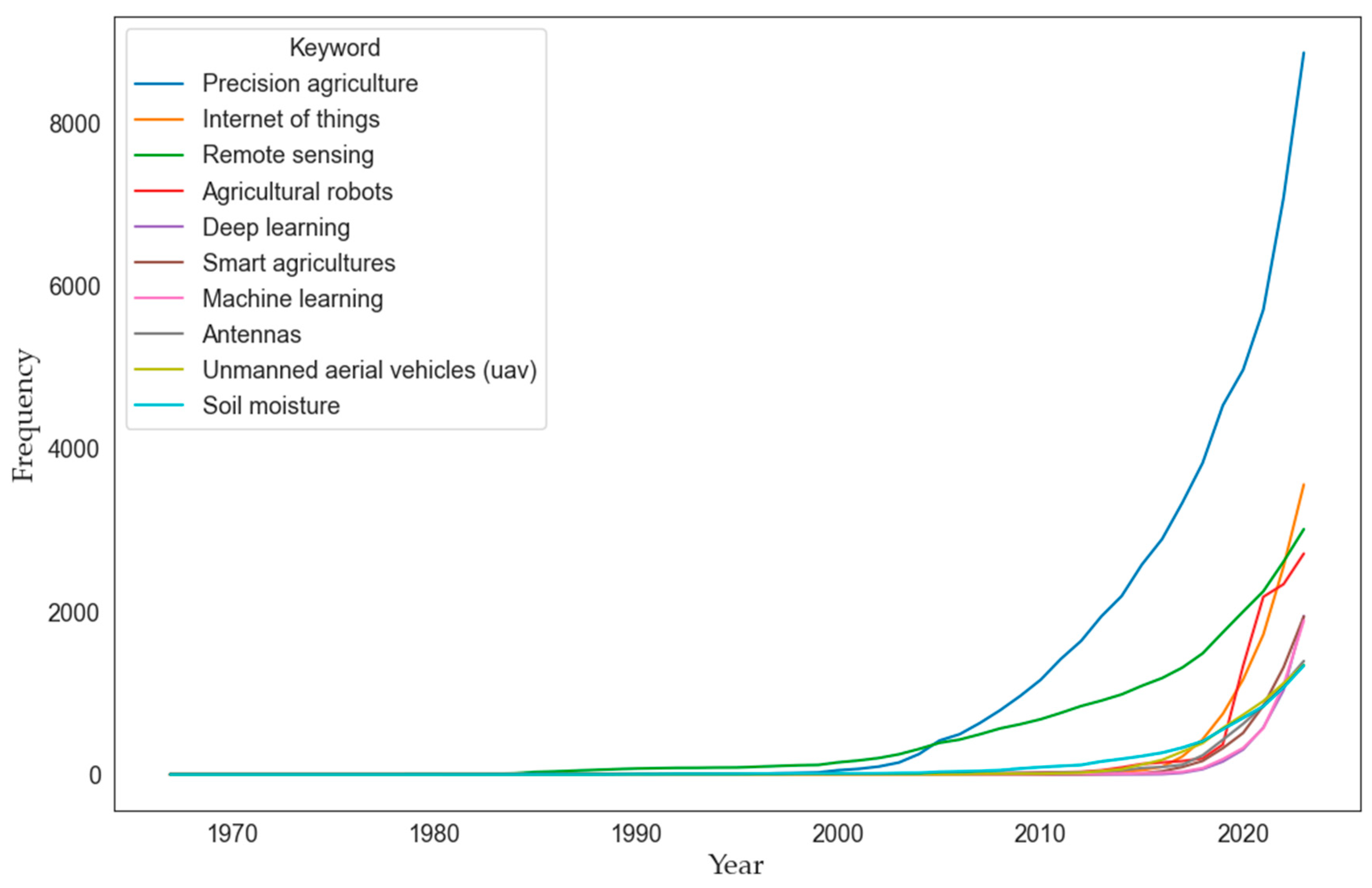
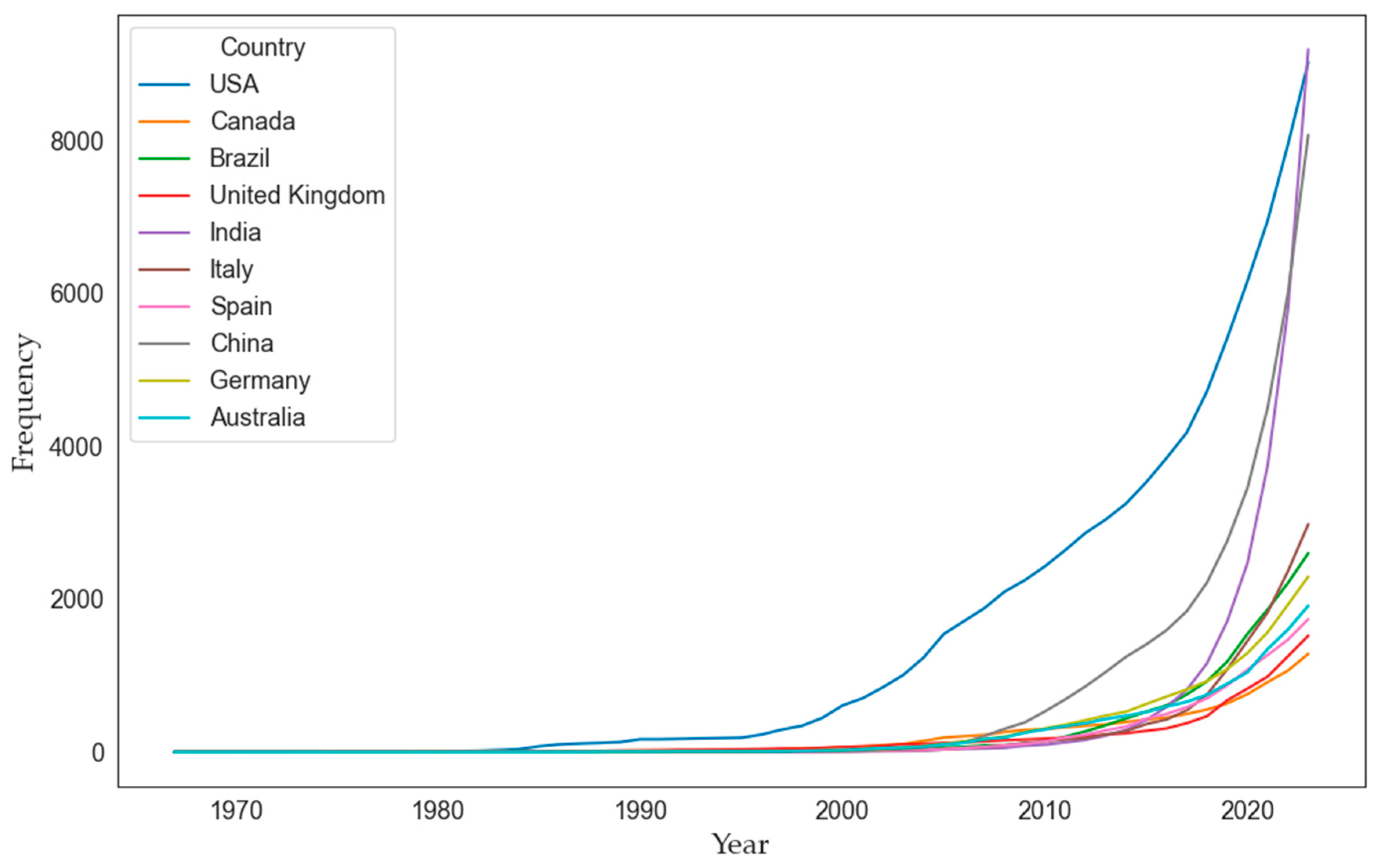

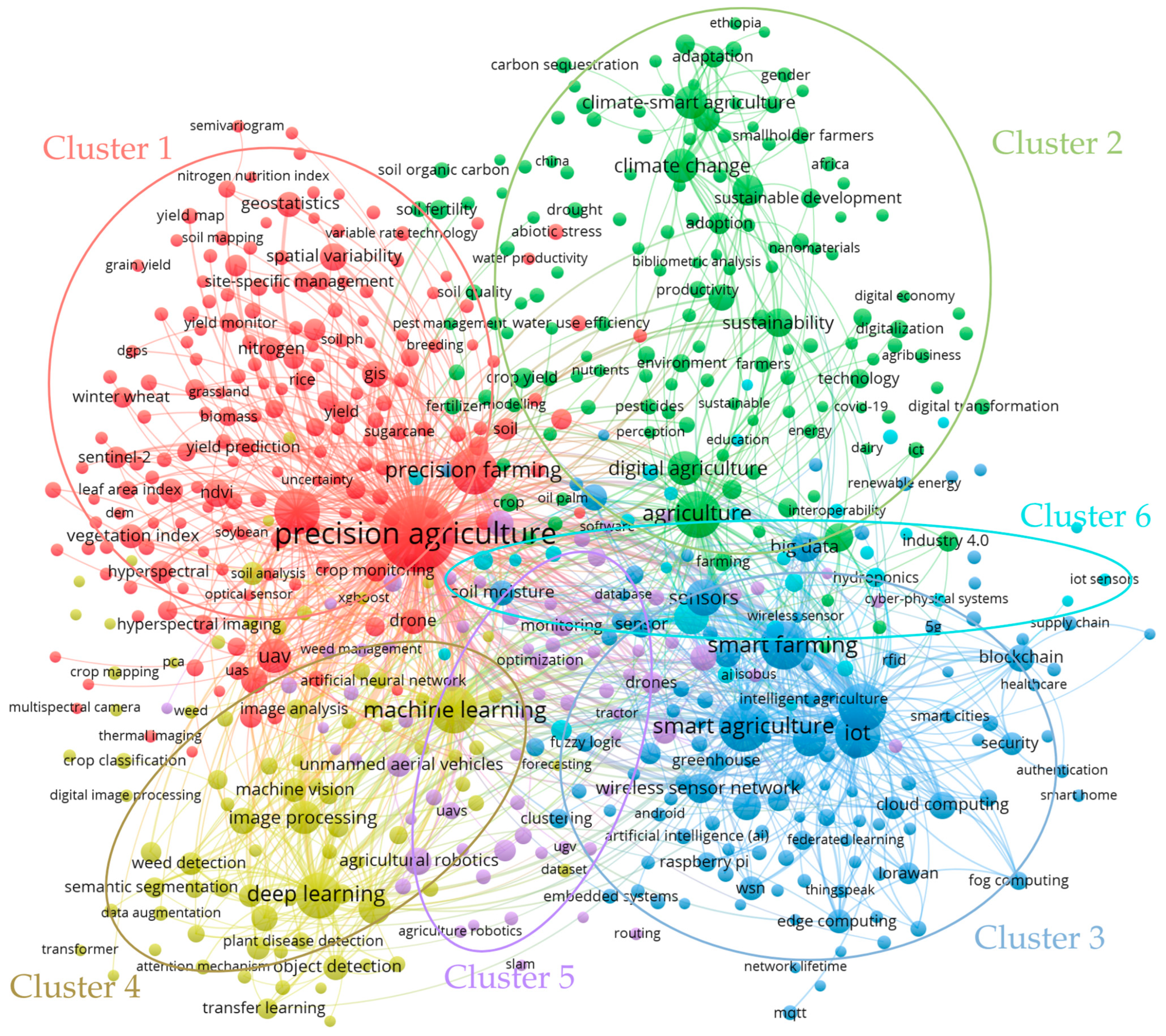
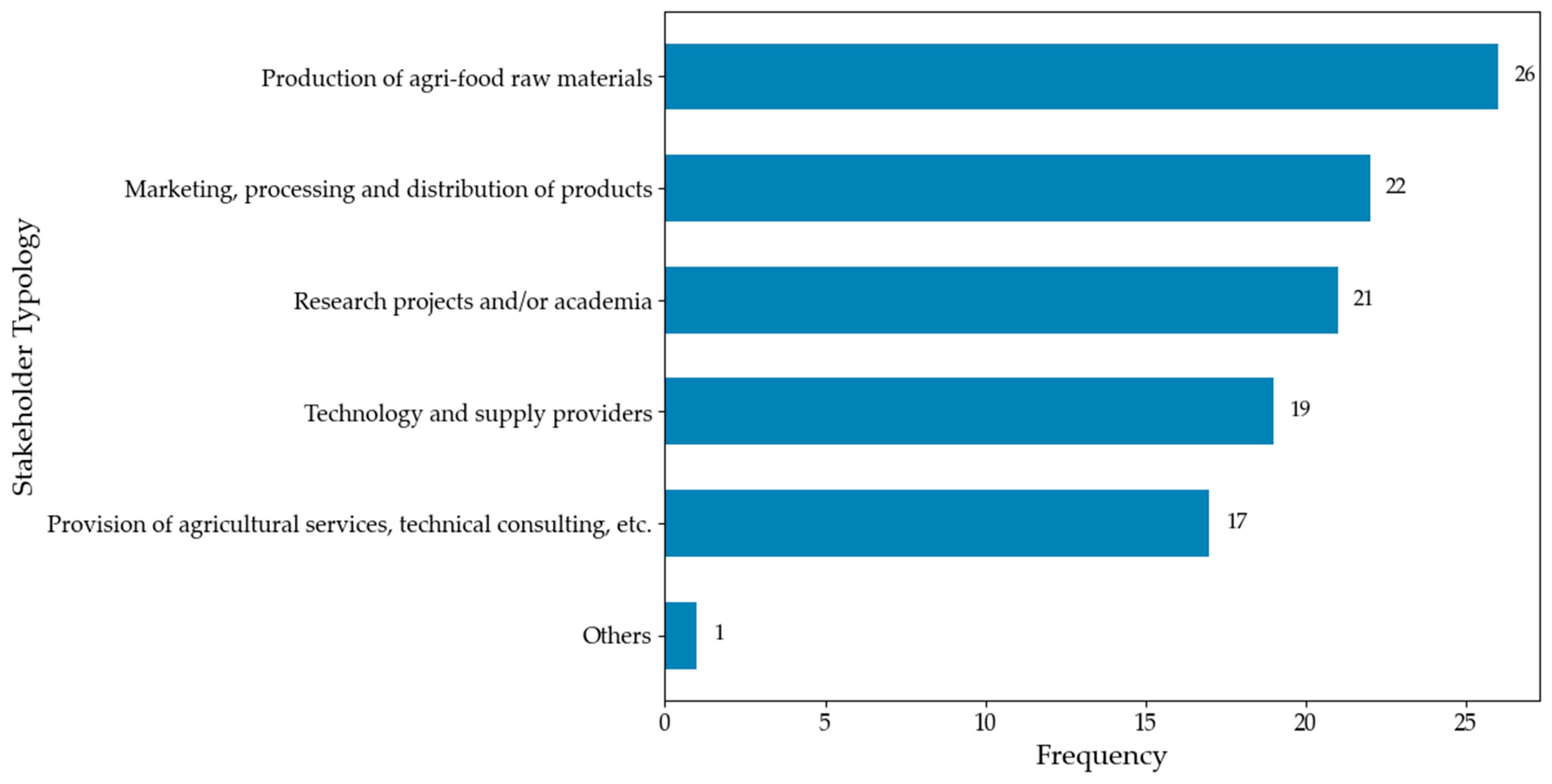

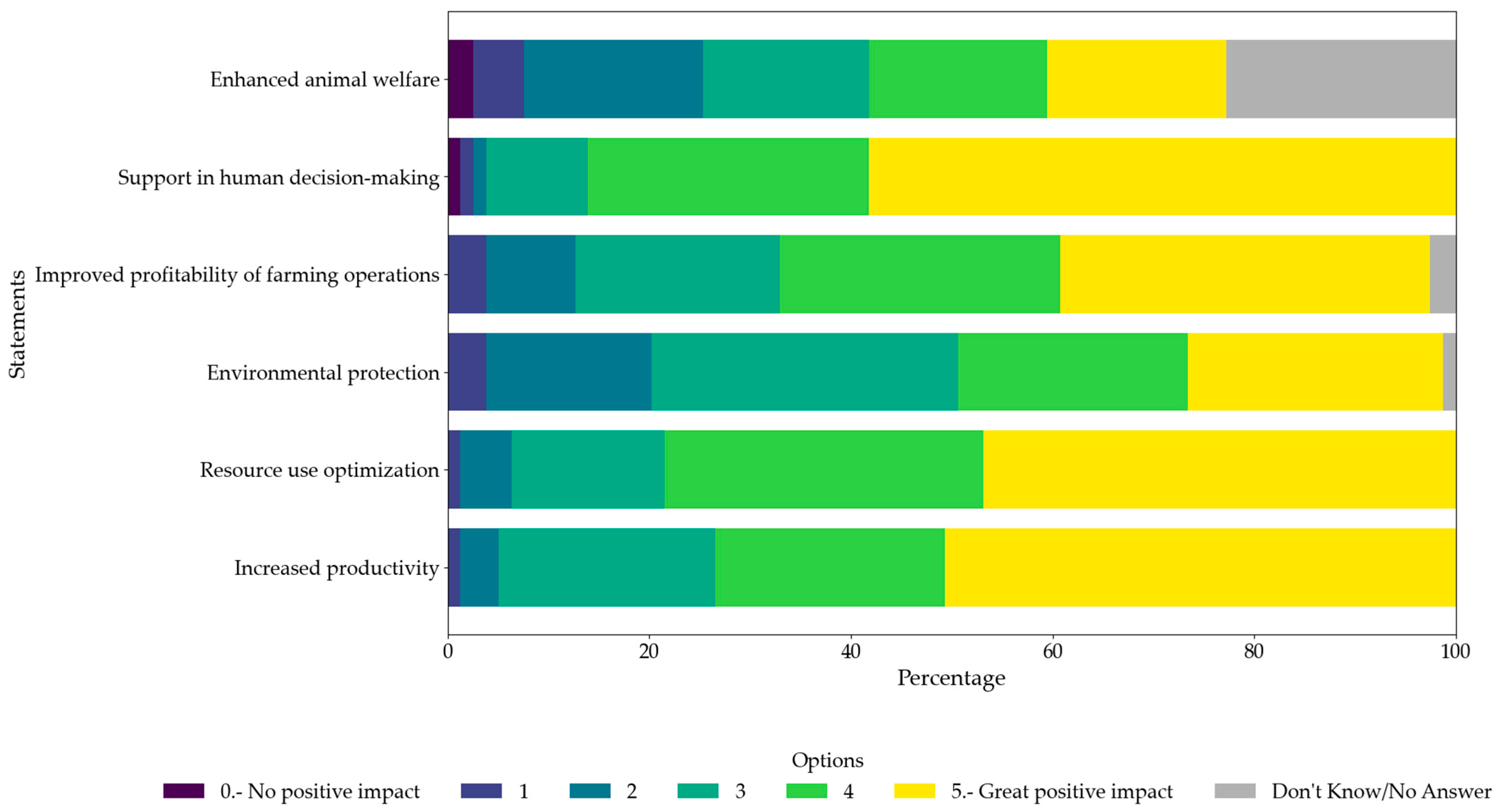
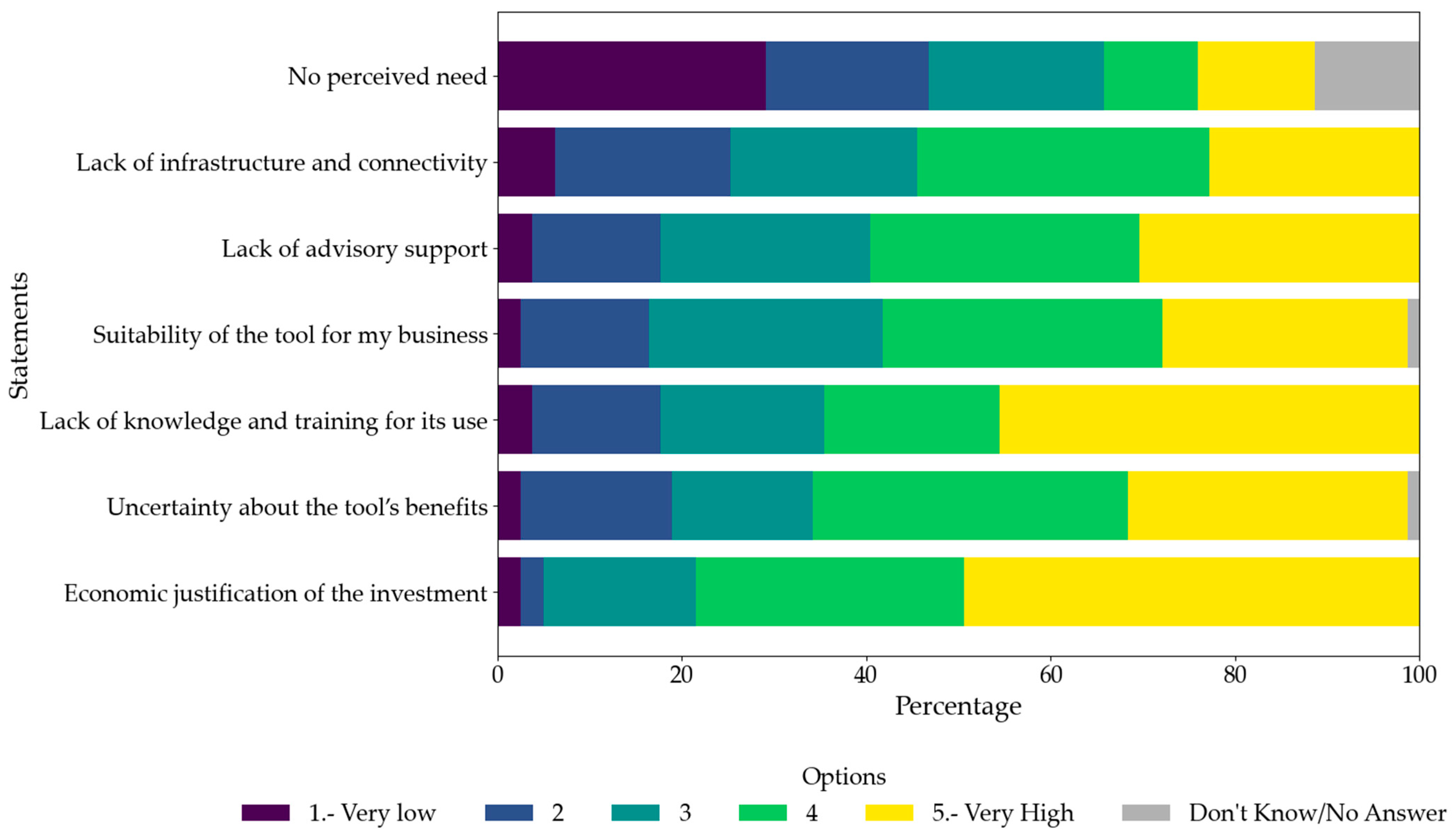

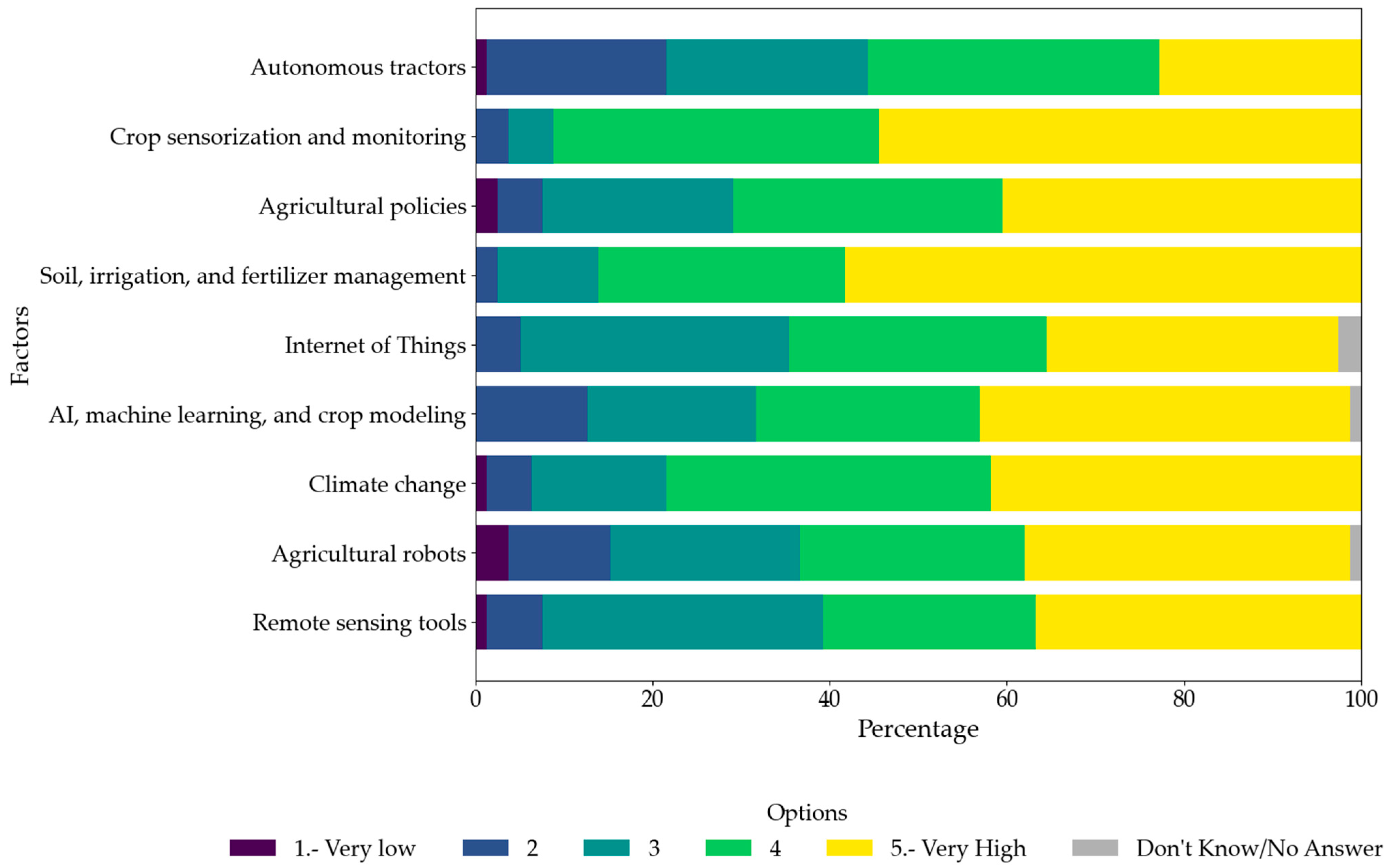
| Group 1: Digitalization and New Technologies | Group 2: Agriculture | Others |
|---|---|---|
| “5.0”, “smart”, “digital*”, “4.0”, “sensors”, “predictive model”, “machine learning”, “deep learning”, “iot”, “sensors”, “precision”, “big data”, “robotic”, “blockchain”, “artificial intelligence”, “remote sensing”, “DSS”, “new technologies”, “internet of things”, “LLM”, “digital twins”, “drones”, “automation” | “farm*”, “agri*”, “crop*” | “agritech” “agtech” |
| Rank | Institution | NP 1 | Country |
|---|---|---|---|
| 1 | China Agricultural University | 436 | China |
| 2 | Wageningen University and Research | 337 | Netherlands |
| 3 | University of Florida | 334 | USA |
| 4 | University of California | 274 | USA |
| 5 | Purdue University | 249 | USA |
| 6 | Nanjing Agricultural University | 227 | China |
| 7 | University of Bonn | 205 | Germany |
| 8 | Iowa State University | 202 | USA |
| 9 | Zhejiang University | 191 | China |
| 10 | University of Nebraska–Lincoln | 160 | USA |
| Variable | Options | Number | % |
|---|---|---|---|
| Age | <23 years | 1 | 1.3% |
| 23–35 years | 34 | 43.0% | |
| 36–50 years | 18 | 22.8% | |
| 51–65 years | 24 | 30.4% | |
| >65 years | 2 | 2.5% | |
| Gender | Male | 69 | 87.3% |
| Female | 10 | 12.7% | |
| Educational level | Primary or Secondary School | 11 | 13.9% |
| High School or Technical degree | 6 | 7.6% | |
| University degree | 62 | 78.5% | |
| Work status | Employed | 48 | 60.8% |
| Self-employed | 26 | 32.9% | |
| Student | 5 | 6.3% |
| High Stakeholder Demand | Low Stakeholder Demand | |
|---|---|---|
| High Research Focus |
|
|
| Low Research Focus |
|
Disclaimer/Publisher’s Note: The statements, opinions and data contained in all publications are solely those of the individual author(s) and contributor(s) and not of MDPI and/or the editor(s). MDPI and/or the editor(s) disclaim responsibility for any injury to people or property resulting from any ideas, methods, instructions or products referred to in the content. |
© 2025 by the authors. Licensee MDPI, Basel, Switzerland. This article is an open access article distributed under the terms and conditions of the Creative Commons Attribution (CC BY) license (https://creativecommons.org/licenses/by/4.0/).
Share and Cite
Luque-Reyes, J.R.; Zidi, A.; Peña-Acevedo, A.; Gallardo-Cobos, R. Assessing Agri-Food Digitalization: Insights from Bibliometric and Survey Analysis in Andalusia. World 2025, 6, 57. https://doi.org/10.3390/world6020057
Luque-Reyes JR, Zidi A, Peña-Acevedo A, Gallardo-Cobos R. Assessing Agri-Food Digitalization: Insights from Bibliometric and Survey Analysis in Andalusia. World. 2025; 6(2):57. https://doi.org/10.3390/world6020057
Chicago/Turabian StyleLuque-Reyes, José Ramón, Ali Zidi, Adolfo Peña-Acevedo, and Rosa Gallardo-Cobos. 2025. "Assessing Agri-Food Digitalization: Insights from Bibliometric and Survey Analysis in Andalusia" World 6, no. 2: 57. https://doi.org/10.3390/world6020057
APA StyleLuque-Reyes, J. R., Zidi, A., Peña-Acevedo, A., & Gallardo-Cobos, R. (2025). Assessing Agri-Food Digitalization: Insights from Bibliometric and Survey Analysis in Andalusia. World, 6(2), 57. https://doi.org/10.3390/world6020057






